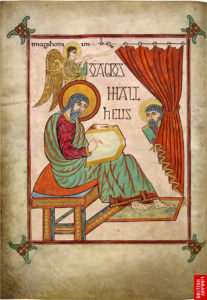793
Vikings attack the monastery at Lindisfarne
Off the eastern coast of Northumbria is the island of Lindisfarne. In the 600s Celtic monks established a priory there which became a centre of Christian learning and evangelism in Anglo-Saxon England. Its calligraphers and illuminators produced one of the ornaments of civilization, the Lindisfarne Gospels, (See the title page of the Book of Matthew below.)
In 793 the island saw the first ever Viking attack on the British Isles. According to the Anglo-Saxon Chronicle:
In this year fierce, foreboding omens came over the land of the Northumbrians, and the wretched people shook; there were excessive whirlwinds, lightning, and fiery dragons were seen flying in the sky. These signs were followed by great famine, and a little after those, that same year on [June 8th], the ravaging of wretched heathen people destroyed God’s church at Lindisfarne.
The ease with which the raid on Lindisfarne had yielded slaves and loot soon spread through Scandinavia and prompted centuries of Viking incursions across Europe. Possessed of the remarkable technology of the longboat, a craft which enabled them to penetrate foreign countries through river systems or challenge the North Atlantic, raiders from Denmark, Norway and Sweden soon appeared everywhere from the Black Sea to the coast of Newfoundland. They raped, looted and pillaged wherever they could or traded when they encountered superior forces. They destroyed kingdoms, established new cities like Dublin, and created new states like Normandy, Norman England, Sicily, or the Duchy of Apuleia. Though Christianity helped to bring an end to the Viking Age, the creative destruction of these northern barbarians was a great engine of change in medieval Europe.

